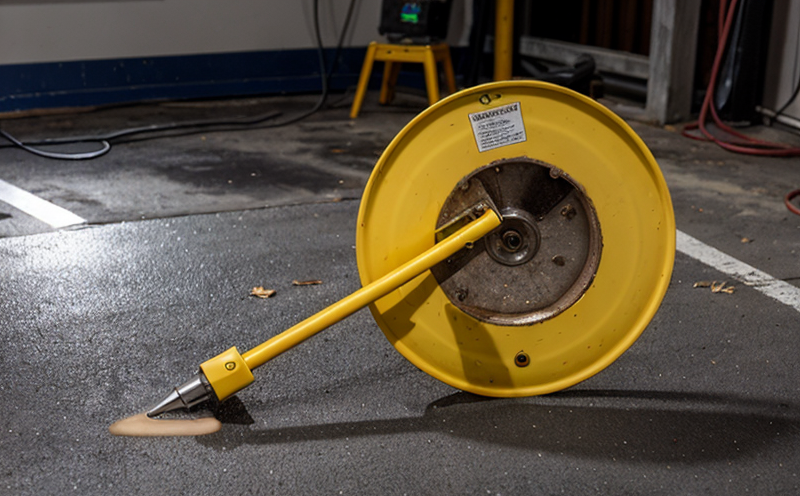ISO 16811 Ultrasonic Testing of Steel Products
The ISO 16811 ultrasonic testing (UT) method is a critical non-destructive evaluation technique used to inspect and assess the integrity, flaws, and defects within steel products. This standard is widely recognized for its accuracy in detecting internal defects such as cracks, porosity, and other imperfections without compromising the structural integrity of the product.
Ultrasonic testing leverages high-frequency sound waves that propagate through the material being inspected. When these sound waves encounter an interface or defect within the steel, they are reflected back to a transducer, which converts them into electrical signals. The resulting waveform provides detailed information about the internal structure of the steel, allowing for precise defect characterization.
The ISO 16811 standard is particularly useful in industries such as aerospace, automotive, and construction, where product reliability and safety are paramount. It ensures that critical components meet stringent quality standards before being integrated into larger systems or structures. The testing process itself involves careful preparation of the steel specimen, calibration of ultrasonic equipment, and detailed recording of test parameters.
One of the key advantages of ISO 16811 UT is its ability to provide real-time feedback on the internal condition of the steel. This allows for immediate corrective actions if any defects are detected. Additionally, the standard specifies clear acceptance criteria that define the permissible levels of flaws and imperfections in the steel product.
Compliance with ISO 16811 is essential for ensuring product reliability and safety, which can significantly reduce the risk of failures or accidents. By adhering to this standard, manufacturers can demonstrate their commitment to quality assurance and regulatory compliance. This not only enhances customer confidence but also contributes to a safer operating environment.
The testing process typically involves several steps: preparation of the steel specimen, calibration of ultrasonic equipment, application of coupling fluid, scanning of the surface area, and analysis of the resulting waveforms. The use of advanced software can help in interpreting the data accurately and efficiently. Once the test is complete, a comprehensive report detailing the findings is generated, which includes detailed information about any defects detected.
ISO 16811 UT is particularly effective for inspecting large or complex steel structures where traditional inspection methods may be impractical or insufficient. Its ability to penetrate deep into the material makes it ideal for detecting flaws that are not accessible through visual inspection alone. This ensures a thorough and reliable assessment of the steel product's condition.
In conclusion, ISO 16811 ultrasonic testing is an indispensable tool in the quality assurance process for steel products. By providing accurate and detailed information about the internal structure of the material, it helps ensure that the product meets stringent quality standards. This not only enhances reliability but also contributes to a safer operating environment.
Applied Standards
The ISO 16811 standard is complemented by other relevant international and industry-specific standards that further enhance the precision and reliability of ultrasonic testing. These include:
- ASTM E584: This standard provides guidelines for the use of ultrasonic testing in the inspection of metallic materials.
- EN 13967-2: This European standard specifies requirements for the qualification, calibration, and performance levels of ultrasonic testing equipment.
- IEC 60584: While not directly related to steel products, this international standard provides specifications for electrical resistors, which can be useful in understanding material properties.
The combination of these standards ensures that the ISO 16811 ultrasonic testing method is consistently applied and interpreted across different industries and regions. This consistency is crucial for ensuring accurate and reliable results.
Scope and Methodology
The scope of ISO 16811 ultrasonic testing encompasses the inspection of various types of steel products, including but not limited to:
- Rolled plates and sheets
- Tubular products such as pipes and tubes
- Forged components like bolts and nuts
- Structural members used in construction and infrastructure projects
The methodology involves several key steps to ensure accurate and reliable results:
- Preparation of the Specimen: The steel product is cleaned and prepared for inspection, ensuring that it is free from contamination.
- Calibration of Equipment: Ultrasonic testing equipment is calibrated using appropriate standards to ensure accurate measurements.
- Application of Coupling Fluid: A coupling fluid is applied between the transducer and the steel surface to improve signal transmission.
- Scanning and Data Collection: The surface area of the steel product is scanned using the ultrasonic probe, and data is collected for analysis.
- Data Analysis: The collected data is analyzed using advanced software to interpret the waveforms and identify any defects.
- Reporting: A comprehensive report detailing the findings is generated, including information about any defects detected.
The acceptance criteria specified in ISO 16811 ensure that only steel products meeting these standards are considered compliant. This includes defining permissible levels of flaws and imperfections within the material.
Benefits
Adopting ISO 16811 ultrasonic testing for steel products offers numerous benefits, including:
- Enhanced Product Reliability: By detecting internal defects early in the manufacturing process, potential failures can be prevented.
- Improved Safety: Ensuring that critical components meet strict quality standards minimizes the risk of accidents or malfunctions.
- Cost Efficiency: Early detection of flaws allows for timely corrective actions, reducing the need for expensive repairs or replacements later on.
- Regulatory Compliance: Adhering to international standards demonstrates a commitment to quality and regulatory requirements.
- Increased Customer Confidence: Consistent application of high-quality testing methods enhances customer trust in the product's reliability and safety.
- Enhanced Reputation: Demonstrating compliance with recognized international standards can significantly improve a company's reputation within the industry.
The use of ISO 16811 ultrasonic testing ensures that steel products meet stringent quality standards, thereby enhancing product reliability and safety. This not only benefits manufacturers but also contributes to a safer operating environment for end-users.





